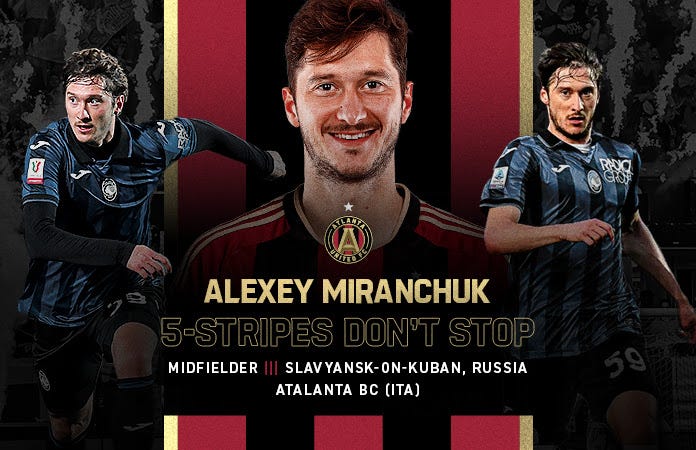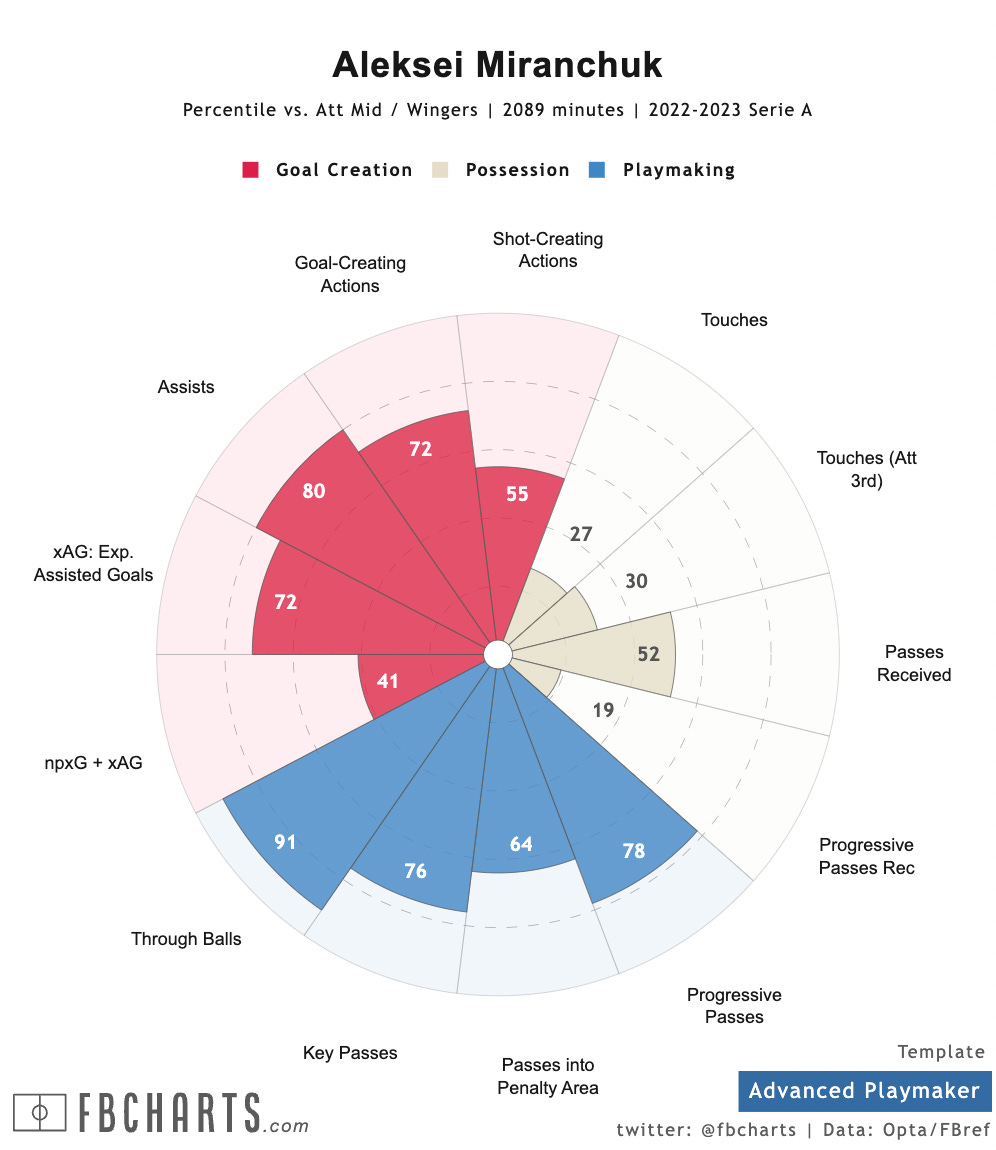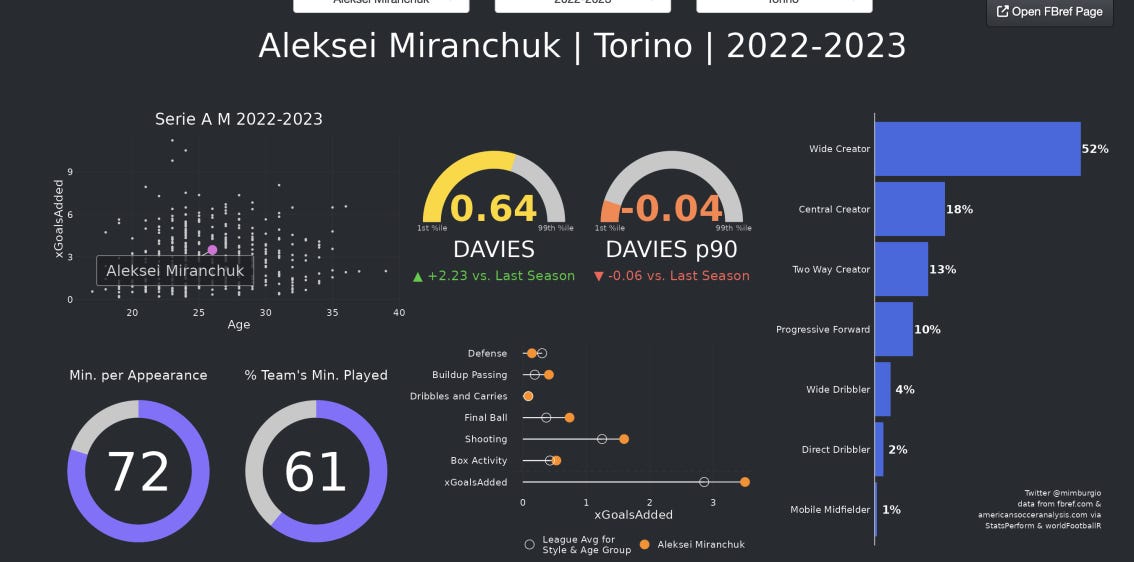Substitute effects and the dangers of hyping up Alexey Miranchuk's per 90 stats
I tried to make this title sound more academic than the rest of the piece will actually be
“I would say that we are back, baby.”
Garth Lagerwey began his post-Alexey Miranchuk signing interview on 92.9 with…”We’re back.”
That’s a helluva statement. I don’t know how tongue-in-cheek it actually was, but either way we can go ahead and chalk it up as Lagerwey rubber-stamping this signing as a no-doubt, slam dunk, sure thing. Sure as the sun rises in the East or that Atlanta United will get bounced from the Leagues Cup group stage, Miranchuk will be the top-five-at-their-position-caliber No. 10 that was promised. He’ll have to be if “We’re back” carried any truth to it.
We won’t know until we know of course whether or not any of that’s true. The bottom line with any signing other than Lionel Messi is that you’ll never, ever know for sure whether a player’s success or lack thereof elsewhere will translate to MLS. However, on the surface, Miranchuk’s statistics paint a picture of the sure thing Lagerwey is talking about.
“Miranchuk is an elite chance creator,” Lagerwey said. “One of the, literally, one of the top guys in all the top five leagues in Europe combined. “We're talking about top five guys in goal contributions, so goals plus assists for 90 minutes. You know, tops in terms of expected assists, tops in terms of key passes.”
There are no lies there. Per FBref, Miranchuk finished in the 98th percentile in non-penalty xG per 90 among attacking midfielders and wingers in Serie A last season. He finished in the 98th percentile in assists, the 98th percentile in expected assists, the 99th percentile in non-penalty xG plus expected assists per 90 and the 99th percentile in shot-creating actions. There’s no denying the fact that his per 90 numbers are outstanding. This? This is gorgeous.
But how real is it?
Substitute Effects
In soccer analytics, there’s a simple idea known as the substitute effect. It’s one of those analytics things that actually lines up with an obvious eye test thing. Players who come on later in games as an attacking substitute are more likely to see a boost in their per-90 attacking statistics. Attacking subs come on in situations that require teams to, ya know, attack. They’re coming in on fresh legs. Playing in the most attack-minded minutes of the game as one of the few players who hasn’t been running around for the previous 70 minutes is going to provide a lift to a player’s per 90 statistics in comparison to when they actually play a full 90. This is one of those things you don’t have to overthink to understand.
Michael Caley recently looked the substitute effect on players in Europe’s top five leagues from 2010 to now. He found that substitutes scored 0.226 goals per 90 compared to 0.11 goals per 90 for starters.
When you account for stoppage time1—which, real quick it should be noted that FBref does not do and it also inflates substitute per 90 numbers—and change the measure to per 96, substitutes score at rate of 0.188 goals per 96 compared to 0.104 per 96 for starters.
If you adjust for position, attacking midfielders score at a rate 0.25 goals per 96 compared to 0.16 per 96 for starters.
If you start looking at other statistics, you see a similar boost across the board. Caley estimates the substitute effects for attacking midfielders typically give more than a 20% increase. To lay it out…
Expected goals: +28.3%
Goals: +49.4%
Expected assists: +33.5%
Assists: +37.3%
Shot attempts: +20.2%
Key passes: +17.9%
Assists: +37.3%
Passes completed: +10.7%
Passes into penalty area: +22.9%
Progressive passes: +17.6%
Carries into penalty area: +32.1%
Progressive carries: +25.6%
Successful Take-ons: +20.1%
Do you get the point? Players who spend life as a substitute can look like gods relative to the mortal versions of themselves that play from the first whistle.
Miranchuk as a substitute
Per FBref, Miranchuk played 269 minutes in 15 appearances as a substitute last season. He played 907 minutes in 12 starts. Unsurprisingly, his per 90 numbers as a substitute make him look a little more impressive.
Goals per 90
Starter: 0.199
Sub: 0.335
Assists per 90
Starter: 0.298
Sub: 0.669
Expected goals per 90
Starter: 0.328
Sub: 0.669
Expected assists per 90
Starter: 0.199
Sub: 0.669
Shot-creating actions per 90
Starter: 5.259
Sub: 9.368
Miranchuk’s per-90s are clearly benefitting from the substitute effect. His numbers as a starter aren’t the kind of 99th-percentile stats that are being touted. If we did some caveman math without context and took and made him a full-time starter, those per 90 numbers would put him around a seven-goal, 11-assist season in Serie A. If you took his 90 numbers with substitute appearances included and made him a full-time starter, he ends up with nine goals and 14 assists over 38 games.
That’s obviously not a huge difference in the grand scheme of things, but it’s certainly enough to skew per 90 numbers. And that’s not even getting into contextual things like Atalanta’s attack-heavy playing style or the fact that 1176 minutes isn’t a massive sample to rely on in the first place.
Miranchuk as a starter
The thing is, we do have a notable and recent example of what Miranchuk is like as a starter. He spent the 2022-23 Serie A season on loan at a Torino team that finished 10th in the 20-team league. He played 2089 minutes and made 26 starts. He scored four times and delivered four assists. His FBref chart isn’t nearly as pretty.
And his DAVIES (think Goals Added) doesn’t exactly get you on your feet and applauding.
So wait, are we panicking or…?
No! You’re not! The thesis here isn’t that Miranchuk is good or bad or will be good or bad in MLS. We’re just thinking about how we think about him coming in. He’s not a 99th-percentile juggernaut gracing us with his presence in MLS. He’s a solid Serie A player coming of his best season with the potential to be that top-five-at-his-position-in-MLS-caliber player Atlanta is hoping for. Lagerwey certainly seems to think they have their guy.
“What we're going all in on now is we're going all in on winning,” Lagerwey said. “And we're going to try to deliver for this fan base. And we understand they suffered a little bit with us. But that's why I say, "We're back." We're bringing in a winner that's been successful in multiple countries. He's in the prime of his career. He's going to be here, he's going to be part of our foundation for a couple of years. And we're going to stabilize this thing, and we're going to move forward.”
All of this might be true! All of it might not! The only thing that’s ever true about MLS is that no one knows what’s going to happen in the future. But what we should at least pump the breaks on is expecting him to win MVP based on his per 90 stats.
Here’s Caley on why that’s so important: First, it’s useful to make a technical point. A football match is 90 minutes long plus stoppage time assessed by the referee. Player minutes as such can be logged either in terms of 90-minute matches, or 90 minutes plus whatever stoppage time is appended. This decision makes a real difference when talking about substitutes. Substitutes almost always finish matches, and most stoppage time is added to the second half.
About 17 percent of substitutes’ time on the pitch occurs in added time, whereas the number is only about five percent for starters.”






cool analysis. I am reminded of people hailing Dom Dwyer due to the substitute effect.
Fair analysis. I am a little surprised GL's exuberance made it out of his mouth. Might feel the temp in the room up a bit.
I'm optimistic. That guy we got from Serie A back in 2017 that looked like quality but couldn't get many starts turned out to be pretty good in MLS.